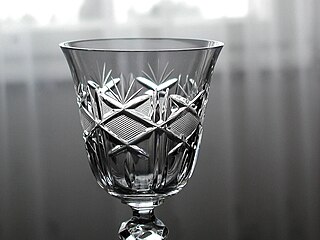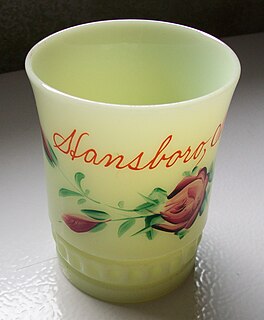
Lead glass, commonly called crystal, is a variety of glass in which lead replaces the calcium content of a typical potash glass. Lead glass contains typically 18–40% lead(II) oxide (PbO), while modern lead crystal, historically also known as flint glass due to the original silica source, contains a minimum of 24% PbO. Lead glass is often desirable for a variety of uses due to its clarity.

Depression glass is glassware made in the period 1929–1939, often clear or colored translucent machine-made glassware that was distributed free, or at low cost, in the United States and Canada around the time of the Great Depression. Depression glass is so called because collectors generally associate mass-produced glassware in pink, yellow, crystal, and green with the Great Depression in America.

Chance Brothers and Company was a glassworks originally based in Spon Lane, Smethwick, West Midlands, in England. It was a leading glass manufacturer and a pioneer of British glassmaking technology.

The A.H. Heisey Company was formed in Newark, Ohio, in 1895 by A.H. Heisey. The factory provided fine quality glass tableware and decorative glass figurines. Both pressed and blown glassware were made in a wide variety of patterns and colors. The company also made glass automobile headlights and Holophane Glassware lighting fixtures. The company was operated by Heisey and his sons until 1957, when the factory closed.

George Ravenscroft was an English businessman in the import/export and glass making trades. He is primarily known for his work in developing clear lead crystal glass in England.
The early modern period in England brought on a revival in local glass production. Medieval glass had been limited to the small-scale production of forest glass for window glass and vessels, predominantly in the Weald. The organisation of production evolved from the small-scale family-run glass houses typical of forest glass-making to large monopolies granted by the Crown. The influx of immigrants from Europe brought changes in furnace technology and raw materials, creating a better quality glass. Monastic decrees later banned the use of wood fuel which was then replaced by the less expensive alternative of coal. The development of lead glass in the late 17th century propelled England to the forefront of the glass industry and paved the way for advancements in the Industrial Revolution.

Henry Clay Fry was an American entrepreneur in the glass industry in the late nineteenth century and early twentieth century.
The Fostoria Glass Company was a manufacturer of pressed, blown and hand-molded glassware and tableware. It began operations in Fostoria, Ohio, on December 15, 1887, on land donated by the townspeople. The new company was formed by men from West Virginia who were experienced in the glassmaking business. They started their company in northwest Ohio to take advantage of newly discovered natural gas that was an ideal fuel for glassmaking. Numerous other businesses were also started in the area, and collectively they depleted the natural gas supply. Fuel shortages caused the company to move to Moundsville, West Virginia in 1891.

The Sneath Glass Company was an American manufacturer of glass and glassware. After a brief 1890s startup in Tiffin, Ohio, the Company moved to Hartford City, Indiana, to take advantage of the Indiana Gas Boom. The small city was enjoying the benefits of the boom, and could provide natural gas as an energy source for manufacturers. Sneath Glass was one of many glass manufacturers that moved to the region, and became Hartford City's second largest employer.
Belmont Glass Company, also known as the Belmont Glass Works, was one of Ohio's early glassmaking companies. It was named after Belmont County, Ohio, where the plant was located. The firm began operations in 1866 in a riverfront village along the east side of the county, which is known as Bellaire. At that time, the community had resource advantages that made it an attractive site for glassmaking. Bellaire's location at the intersection of the Ohio River, the National Road, and two railroads meant it had an excellent transportation infrastructure. Fuel necessary for the glassmaking process was also readily available, since Belmont County was part of the eastern Ohio coal region. Bellaire also had a workforce with glassmaking expertise located less than five miles away, since glass had been produced in Wheeling, West Virginia, since the 1820s.
The Macbeth-Evans Glass Company was an American glass company that created "almost every kind of glass for illuminating, industrial and scientific purposes," but is today famous for making depression glass.

The history of glass-making dates back to at least 3,600 years ago in Mesopotamia, however some claim they may have been producing copies of glass objects from Egypt. Other archaeological evidence suggests that the first true glass was made in coastal north Syria, Mesopotamia or Egypt. The earliest known glass objects, of the mid 2,000 BC, were beads, perhaps initially created as the accidental by-products of metal-working (slags) or during the production of faience, a pre-glass vitreous material made by a process similar to glazing. Glass products remained a luxury until the disasters that overtook the late Bronze Age civilizations seemingly brought glass-making to a halt.
Early American molded glass refers to glass functional and decorative objects, such as bottles and dishware, that were manufactured in the United States in the 19th century. The objects were produced by blowing molten glass into a mold, thereby causing the glass to assume the shape and pattern design of the mold. When a plunger rather than blowing is used, as became usual later, the glass is technically called pressed glass. Common blown molded tableware items bearing designs include salt dishes, sugar bowls, creamers, celery stands, decanters, and drinking glasses.
The New Bedford Museum of Glass, located in New Bedford, Massachusetts, is home to a wide collection of glass ranging from ancient Mediterranean unguent bottles to designs by contemporary artists such as Dale Chihuly.
Seneca Glass Company used to be the largest manufacturer of tumblers in the United States. The company was also known for its high-quality lead stemware, which was hand-made for nearly a century. Customers included Eleanor Roosevelt, Lyndon Johnson, the president of Liberia, the Ritz Carlton Hotel, Tiffany's, and Neiman-Marcus.
Evidence for early glassmaking in the United States has been found of glassmaking at the English settlement on Jamestown Island, Virginia. While some glass window panes were made there after 1608, most of the windows had been shipped from England.
J. H. Hobbs, Brockunier and Company was one of the largest and best known manufacturers of glass in the United States in the 19th century. Its products were distributed world-wide. The company is responsible for one of the greatest innovations in American glassmaking—an improved formula for lime glass that enabled American glass makers to produce high-quality glass at a lower cost. The firm also developed many of the talented glassmakers that started glass factories in Ohio and Indiana.

Bryce Brothers, also known as Bryce Brothers Company and Bryce Brothers Company Inc., was a glass manufacturing company originating in 1850 at Birmingham, Allegheny County, Pennsylvania that changed names and partnerships until being purchased by the Bryce family when it was moved to Mount Pleasant, Pennsylvania, where they continued to produced blown crystal glassware until 1965.
Indiana Glass Company manufactured pressed, blown and hand-molded glassware and tableware for almost 100 years. Predecessors to the company began operations in Dunkirk, Indiana, in 1896 and 1904, when East Central Indiana experienced the Indiana gas boom. The start date for the company is considered 1907, when a group of investors led by Frank W. Merry formed a company to buy the Dunkirk glass plant that belonged to the bankrupt National Glass Company. National Glass was a trust for glass tableware that originally owned 19 glass factories including the plant in Dunkirk. National Glass went bankrupt in 1907, and its assets were sold in late 1908.













